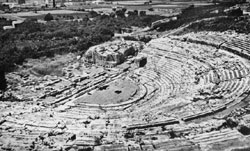
The Theatre of Syracuse
The ancient Theatre of Syracuse, which is of exceptional importance in the history of the ancient theatre, is hewn into the limestone of the Temenite hill; its cavea (semicircular seating area) faces the great harbour (Porto Grande). Historical records of its existence exist since the early 5th century BC. We even know the name of its architect, Democopos, nicknamed Myrilla for having ordered the distribution of perfumes (myroi) on the day of its inauguration. It was the theatre in which the tragedies of Aeschylus and the comedies of Epicharmos were performed, but it was also there that meetings of the people of Syracuse were held and civic affairs were discussed in the presence of the assembled citizenry. The theatre underwent various modifications in the course of time; it was transformed during the Roman imperial period. The study conducted on it by Luigi Bernaḅ Brea was aimed at better defining its chronology, architectural characteristics and building phases.
Bibliography:
- L. Bernabò Brea, Studi sul teatro greco di Siracusa, in "Palladio" Anno XVII, n. I-IV – Gennaio Dicembre 1967, pp.97-154.
- C. Voza, Guida di Siracusa, Siracusa 1994, pp.193-200.
